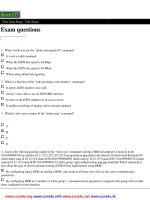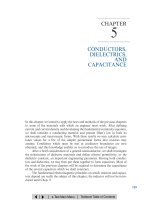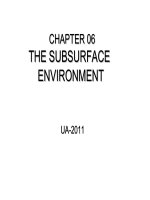Chapter5 a
Bạn đang xem bản rút gọn của tài liệu. Xem và tải ngay bản đầy đủ của tài liệu tại đây (1.14 MB, 32 trang )
Chapter 5: The Data Link Layer
Our goals:
Overview:
understand principles
link layer services
error detection, correction
behind data link layer
services:
error detection,
correction
sharing a broadcast
channel: multiple access
link layer addressing
reliable data transfer,
flow control: done!
instantiation and
implementation of various
link layer technologies
multiple access protocols and
LANs
link layer addressing, ARP
specific link layer technologies:
Ethernet
hubs, bridges, switches
IEEE 802.11 LANs
PPP
5: DataLink Layer
5a-1
Link Layer: setting the context
5: DataLink Layer
5a-2
Link Layer: setting the context
two physically connected devices:
host-router, router-router, host-host
unit of data: frame
M
Ht M
Hn Ht M
Hl Hn Ht M
application
transport
network
link
physical
data link
protocol
phys. link
adapter card
network
link
physical
Hl Hn Ht M
frame
5: DataLink Layer
5a-3
Link Layer Services
Framing, link access:
encapsulate datagram into frame, adding header, trailer
implement channel access if shared medium,
‘physical addresses’ used in frame headers to identify
source, dest
• different from IP address!
Reliable delivery between two physically connected
devices:
we learned how to do this already (chapter 3)!
seldom used on low bit error link (fiber, some twisted pair)
wireless links: high error rates
• Q: why both link-level and end-end reliability?
5: DataLink Layer
5a-4
Link Layer Services (more)
Flow Control:
pacing
between sender and receivers
Error Detection:
errors caused by signal attenuation, noise.
receiver detects presence of errors:
• signals sender for retransmission or drops frame
Error Correction:
identifies and corrects bit error(s)
without resorting to retransmission
receiver
5: DataLink Layer
5a-5
Link Layer: Implementation
implemented in “adapter”
e.g., PCMCIA card, Ethernet card
typically includes: RAM, DSP chips, host bus
interface, and link interface
M
Ht M
Hn Ht M
Hl Hn Ht M
application
transport
network
link
physical
data link
protocol
phys. link
adapter card
network
link
physical
Hl Hn Ht M
frame
5: DataLink Layer
5a-6
Error Detection
EDC= Error Detection and Correction bits (redundancy)
D = Data protected by error checking, may include header fields
• Error detection not 100% reliable!
• protocol may miss some errors, but rarely
• larger EDC field yields better detection and correction
5: DataLink Layer
5a-7
Parity Checking
Single Bit Parity:
Detect single bit errors
Two Dimensional Bit Parity:
Detect and correct single bit errors
0
0
5: DataLink Layer
5a-8
Internet checksum
Goal: detect “errors” (e.g., flipped bits) in transmitted
segment (note: used at transport layer only)
Sender:
treat segment contents
as sequence of 16-bit
integers
checksum: addition (1’s
complement sum) of
segment contents
sender puts checksum
value into UDP checksum
field
Receiver:
compute checksum of
received segment
check if computed checksum
equals checksum field value:
NO - error detected
YES - no error detected.
But maybe errors
nonethless? More later ….
5: DataLink Layer
5a-9
Checksumming: Cyclic Redundancy Check
view data bits, D, as a binary number
choose r+1 bit pattern (generator), G
goal: choose r CRC bits, R, such that
<D,R> exactly divisible by G (modulo 2)
receiver knows G, divides <D,R> by G. If non-zero remainder:
error detected!
can detect all burst errors less than r+1 bits
widely used in practice (ATM, HDCL)
5: DataLink Layer 5a-10
CRC Example
Want:
D.2r XOR R = nG
equivalently:
D.2r = nG XOR R
equivalently:
if we divide D.2r by
G, want reminder R
D.2r
R = remainder[
]
G
5: DataLink Layer 5a-11
Multiple Access Links and Protocols
Three types of “links”:
point-to-point (single wire, e.g. PPP, SLIP)
broadcast (shared wire or medium; e.g, Ethernet,
Wavelan, etc.)
switched (e.g., switched Ethernet, ATM etc)
5: DataLink Layer 5a-12
Multiple Access protocols
single shared communication channel
two or more simultaneous transmissions by nodes:
interference
only one node can send successfully at a time
multiple access protocol:
distributed algorithm that determines how stations share channel,
i.e., determine when station can transmit
communication about channel sharing must use channel itself!
what to look for in multiple access protocols:
• synchronous or asynchronous
• information needed about other stations
• robustness (e.g., to channel errors)
• performance
5: DataLink Layer 5a-13
Multiple Access protocols
claim: humans use multiple access protocols
all the time
class can "guess" multiple access protocols
multiaccess
protocol
multiaccess protocol
multiaccess protocol
multiaccess protocol
1:
2:
3:
4:
5: DataLink Layer 5a-14
MAC Protocols: a taxonomy
Three broad classes:
Channel Partitioning
divide channel into smaller “pieces” (time slots,
frequency)
allocate piece to node for exclusive use
Random Access
allow
collisions
“recover” from collisions
“Taking turns”
tightly coordinate shared access to avoid collisions
Goal: efficient, fair, simple, decentralized
5: DataLink Layer 5a-15
Channel Partitioning MAC protocols: TDMA
TDMA: time division multiple access
access to channel in "rounds"
each station gets fixed length slot (length = pkt trans time) in each round
unused slots go idle
example: 6-station LAN, 1,3,4 have pkt, slots 2,5,6 idle
TDM (Time Division Multiplexing): channel divided into N time slots, one per
user; inefficient with low duty cycle users and at light load.
FDM (Frequency Division Multiplexing): frequency subdivided.
5: DataLink Layer 5a-16
Channel Partitioning MAC protocols: FDMA
FDMA: frequency division multiple access
channel spectrum divided into frequency bands
each station assigned fixed frequency band
frequency bands
unused transmission time in frequency bands go idle
example: 6-station LAN, 1,3,4 have pkt, frequency bands 2,5,6 idle
time
TDM (Time Division Multiplexing): channel divided into N time slots, one per user;
inefficient with low duty cycle users and at light load.
FDM (Frequency Division Multiplexing): frequency subdivided.
5: DataLink Layer 5a-17
Channel Partitioning (CDMA)
CDMA (Code Division Multiple Access)
unique “code” assigned to each user; ie, code set partitioning
used mostly in wireless broadcast channels (cellular,
satellite,etc)
all users share same frequency, but each user has own
“chipping” sequence (ie, code) to encode data
encoded signal = (original data) X (chipping sequence)
decoding: inner-product of encoded signal and chipping
sequence
allows multiple users to “coexist” and transmit
simultaneously with minimal interference (if codes are
“orthogonal”)
5: DataLink Layer 5a-18
CDMA Encode/Decode
5: DataLink Layer 5a-19
CDMA: two-sender interference
5: DataLink Layer 5a-20









